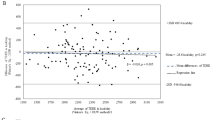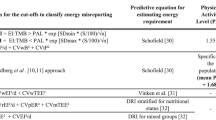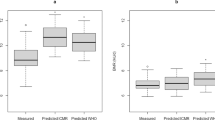Abstract
Background/objectives
Accurate estimation of energy requirements is crucial for health maintenance and prevention of malnutrition in older adults. This study aimed to assess the accuracy of predictive equations for estimating energy requirements in older adults and to test the validity of new predictive equations for this age group.
Subjects/methods
This is a cross-sectional study including 38 Brazilian community-dwelling older adults aged 60–84 years, who had their total energy expenditure measured by doubly labeled water (TEEDLW). The energy expenditure was compared to the Institute of Medicine (Dietary Reference Intake (DRI)) and Vinken et al. previous predictive equations and three predictive models developed in a modeling sample. The agreement was assessed using intra-class correlation coefficient, Bland–Altman plots, and Lin’s concordance correlation. Accuracy was evaluated considering ±10% of the ratio between estimated and measured energy expenditure.
Results
The mean (standard deviation) TEEDLW was 2656.7 (405.6) kcal/day for men and 2168.9 (376.9) for women. Vinken et al. and both DRI equations presented moderate to good degree of agreement, while the developed models vary from fair to very good agreement in comparison to DLW. The accuracy rate was the same for both DRI equations and Vinken et al. equation (60.53%). The new equations developed in this study had accuracy in predicting TEE for Brazilian older adults varying from 43.11% to 73.68%.
Conclusions
The results corroborate the use of previous predictive equations for estimating energy requirements in Brazilian older adults. Further studies have the potential to explore the use of the developed models to assess energy needs in this population.
This is a preview of subscription content, access via your institution
Access options
Subscribe to this journal
Receive 12 print issues and online access
$259.00 per year
only $21.58 per issue
Buy this article
- Purchase on Springer Link
- Instant access to full article PDF
Prices may be subject to local taxes which are calculated during checkout

Similar content being viewed by others
References
Leslie W, Hankey C. Aging, nutritional status and health. Healthcare.2015;3:648–58.
Amarya S, Singh K, Sabharwal M. Changes during aging and their association with malnutrition. J Clin Gerontol Geriatr. 2015;6:78–84.
Shlisky J, Bloom DE, Beaudreault AR, Tucker KL, Keller HH, Freund-Levi Y, et al. Nutritional considerations for healthy aging and reduction in age-related chronic disease. Adv Nutr. 2017;8:17–26.
Cooper JA, Manini TM, Paton CM, Yamada Y, Everhart JE, Cummings S, et al. Longitudinal change in energy expenditure and effects on energy requirements of the elderly. Nutr J. 2013;12:12–73.
Hill JO, Wyatt HR, Peters JC. The importance of energy balance. Eur Endocrinol. 2013;9:111–5.
Porter J, Nguo K, Gibson S, Huggins CE, Collins J, Kellow NJ, et al. Total energy expenditure in adults aged 65 years and over measured using doubly-labelled water: international data availability and opportunities for data sharing. Nutr J. 2018;17:17–40.
Vinken AG, Bathalon GP, Sawaya AL, Dallal GE, Tucker KL, Roberts SB. Equations for predicting the energy requirements of healthy adults aged 18–81 y. Am J Clin Nutr. 1999;69:920–6.
IOM/Food and Nutrition Board. Dietary reference intakes for energy, carbohydrate, fiber, fat, fatty acids, cholesterol, protein, and amino acids (macronutrients). Washington D.C.: The National Academies Press; 2005;5:107–264.
Ndahimana D, Go N-Y, Ishikawa-Takata K, Park J, Kim E-K. Validity of the dietary reference intakes for determining energy requirements in older adults. Nutr Res Pract. 2019;13:256.
Fisberg R, Sales C, Fontanelli M, Pereira J, Alves M, Escuder M, et al. 2015 health survey of São Paulo with focus in nutrition: rationale, design, and procedures. Nutrients. 2018;10:169.
Primer K, Vilela M, Resende CM, Scagliusi FB, Marchini JS, Lima NKC, et al. Under-reporting of food intake and body fatness of independent older people: a doubly labelled water study. Age Ageing. 2015;44:103–8.
Ferrioli E, Cruz BM, Pfrimer K. Uso de isótopos leves em ciências nutricionais. In: Dutra JE, Marchini S, editors. Ciências nutricionais: aprendendo a aprender. 2nd ed. São Paulo: Sarvier; 2008. 23, p. 443–64.
Coward WA, Ritz P, Cole TJ. Revision of calculations in the doubly labeled water method for measurement of energy expenditure in humans. Am J Physiol—Endocrinol Metabol. 1994;267:805–7.
PAHO. Pan-American Health Organization. XXXVI Reunión del Comitê Asesor de Ivestigaciones en Salud—Encuestra Multicêntrica—Salud Beinestar y Envejecimeiento (SABE) en América Latina e el Caribe—Informe preliminar. 2001. http://envejecimiento.csic.es/documentos/documentos/paho-salud-01.pdf. Accessed 08 Aug 2019.
Diener J. Calorimetria indireta. Rev Assoc Méd Bras. 1997;43:245–53.
Fleiss J. The design and analysis of clinical experiments. New York: John Wiley & Sons; 1986. p. 1e33.
Altman DG. Practical statistics for medical research. London: Chapman and Hall; 1991. p. 404.
Porter J, Nguo K, Collins J, Kellow N, Huggins CE, Gibson S, et al. Total energy expenditure measured using doubly labeled water compared with estimated energy requirements in older adults (≥65 y): analysis of primary data. Am J Clin Nutr. 2019;110:1353–61.
Tooze JA, Schoeller DA, Subar AF, Kipnis V, Schatzkin A, Troiano RP. Total daily energy expenditure among middle-aged men and women: the OPEN study. Am J Clin Nutr. 2007;86:382–7.
Plucker A, Thomas DM, Broskey N, Martin CK, et al. Adult energy requirements predicted from doubly labeled water. Int J Obes. 2018;42:1515–23.
Acknowledgements
We would like to thank all fieldworkers and all participants. We also acknowledge the work of the Dietary Intake Research Group (Grupo de Avaliação do Consumo Alimentar) at the University of São Paulo and the workers at the Isotope Ratio Mass Spectrometry Laboratory of the Ribeirão Preto Medical School—University of São Paulo, Brazil.
Funding
This work was supported by the São Paulo Research Foundation (grant number 2018/01991-4) and the National Council for Scientific and Technological Development (grant number 134149/2018-1). The Health Survey of São Paulo was supported by the São Paulo Municipal Health Department (grant number 2013-0.235.936-0), São Paulo Research Foundation (grant numbers 98/14099-7, 2007/51488-2, 2009/15831-0, 2012/22113-9), and National Council for Scientific and Technological Development (grant numbers 502948/2003-5, 481176/2008-0, 473100/2009-6, 472873/2012-1, 402674/2016-2, 301597/2017-0).
Author information
Authors and Affiliations
Contributions
LDB contributed to conception and design of the study, analysis and interpretation of findings, and drafting the article. MMF and NAGF contributed to interpretation of findings, and revising it critically for important intellectual content. RMF contributed to conception and design of the study, data acquisition, and revising it critically for important intellectual content. KP and EF contributed to data acquisition, and revising it critically for important intellectual content. All authors approved the final version to be published.
Corresponding author
Ethics declarations
Conflict of interest
The authors declare that they have no conflict of interest.
Additional information
Publisher’s note Springer Nature remains neutral with regard to jurisdictional claims in published maps and institutional affiliations.
Supplementary information
Rights and permissions
About this article
Cite this article
Batista, L.D., De França, N.A.G., Pfrimer, K. et al. Estimating total daily energy requirements in community-dwelling older adults: validity of previous predictive equations and modeling of a new approach. Eur J Clin Nutr 75, 133–140 (2021). https://doi.org/10.1038/s41430-020-00717-0
Received:
Revised:
Accepted:
Published:
Issue Date:
DOI: https://doi.org/10.1038/s41430-020-00717-0
This article is cited by
-
Misreporting of dietary energy intake obtained by 24 h recalls in older adults: a comparison of five previous methods using doubly labeled water
European Journal of Clinical Nutrition (2022)



